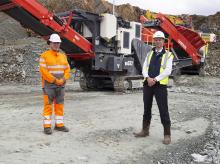
In 2020, after the eastern Oklahoma company saw an opportunity to delve further into the aggregate market, Bluebird Stone owner Tommy Caldwell partnered with local distributor Crushing Tigers and expanded his range of Sandvik equipment.
"I was only crushing our rock for roadways in our quarry," says Caldwell, "though I sometimes would sell the material when someone came into the yard and wanted it. Now we're doing a thousand tons of crushed rock a day, five days a week."
This was a sea-change for the 18-year-old company. Bluebird Stone's reputation was built on beautiful natural countertop and tabletop stone slabs and construction-grade veneer and patio flagstones. The company is one of the largest producers of natural and dimensional stone in the Midwest, and this year will do some US$8 million in that area of production. The business's largest project was natural sandstone placement in walkways and on the facing of archways in Tulsa's Gathering Place. The development consumed 20,000 tons of decorative and functional stone.
All of Bluebird's products are harvested from eight operating quarries. Caldwell looked to Sandvik representatives Crushing Tigers to shift gears and begin to produce meaningful quantities of crushed rock products from some of that raw material. Together, they selected a set-up of four tracked machines to make the aggregate.
It begins with a QJ341 jaw crusher, a 46-foot-long machine powered by a 375-hp engine and capable of handling 440 tons per hour of material. It crushes stone to 4 inches in diameter or less. The unit can reverse-feed the material in case of jams and is hydraulically driven to facilitate start-ups under load. Says Caldwell: "We tried everything in that spot, and this model worked the best. We have a thousand hours on it, and it holds up well."
The crusher feeds a QE342 scalper, a 31-ton unit designed for high production of notably dense material—the scalper ferrets out existing 1½-inch gravel. Bluebird Stone material is notably hard and abrasive, but the scalper features an especially wear-resistant steel feeder and hopper to resist the abrasion of processing such rock. A 132-hp engine powers the machine.
A QH332 Hydrocone crusher was next in the lineup to accept the jaw-crushed material. The QH332 is a versatile machine with a choice of six crushing chambers. It's powerful, too, with a 350-hp engine doing the hard work of further reducing the jaw crusher feed. Sandvik representatives Crushing Tigers recommended that the crusher model was a perfect fit for the other equipment in the set-up. "We don't just sell what a customer wants. We try to sell what he needs based on his rock," says Darragh Bonfil, territory manager of Crushing Tigers.
The final component in the Bluebird Stone aggregate production process is a QA451 triple-deck Doublescreen. The screen delivers fine product less than ¾ inches in diameter, full ¾-inch rock for concrete, and lateral line rock that ranges from an inch to 1½ inches in size. Caldwell traded an older model screen for the QA451, utilising two screen boxes to maximise throughput, control and screening efficiency.
"He needed the Doublescreen to make their fine aggregate for concrete material," says Darragh Bonfil from Crushing Tigers, who worked closely with Bluebird Stone. "We pride ourselves on knowing our customer's rock and are totally familiar with Tommy's flagstone."
The alignment of Sandvik crushers and screens proved itself over the first year of operation, and the Oklahoma company now has a flourishing aggregate product line. "It was exciting what we did our first year in business," the company owner says. Looking ahead, he hopes in the future "to have a year-upon-year business increase of 25 per cent."
Sandvik sales manager Tim Winslow said Bluebird Stone's needs were quickly met partly because of the versatility of the Sandvik equipment. "The beauty of these products is that they are flexible, compatible with one another, and easy and quick to set up. With the inherent flexibility with a choice of chambers and eccentric throws to match the customer's aggregate requirements, each of our cone crushers, for example, crushes aggregate to almost any size. The customer wanted to go into a new line of business and was able to do so by investing in this train of four machines."
When the Bluebird Stone owner needs solutions, Caldwell says he keeps turning to mobile Sandvik equipment for reasons beyond the equipment's capability. One reason is his affinity for Caterpillar products. He has 53 pieces of Cat equipment doing his quarry work—and the Sandvik equipment is Cat-powered.
But a chief selling point for him is the support he receives from Crushing Tigers. He traces his trust in the distributor to an incident a decade ago with a newly purchased Sandvik crusher. "They took it back to find out why it wasn't performing," Caldwell recalls. "They didn't just fix the problem; they worked to find out why it happened."
He adds: "Once a month, someone shows up here wanting me to buy some other machinery, and I just run the guy out the door."
For a company to successfully reposition itself in the marketplace as Bluebird Stone did was audacious. Had the new-market initiative backfired and alienated the company's core clientele for natural stone products, it might have been deemed foolhardy.
But the complementary move into aggregate production and sales did succeed, and continued growth seems certain with highway and bridge infrastructure again on the national agenda. Credit for the success goes to Bluebird Stone's confident leadership and trust in a line of versatile equipment that took the company where a new market awaited.








